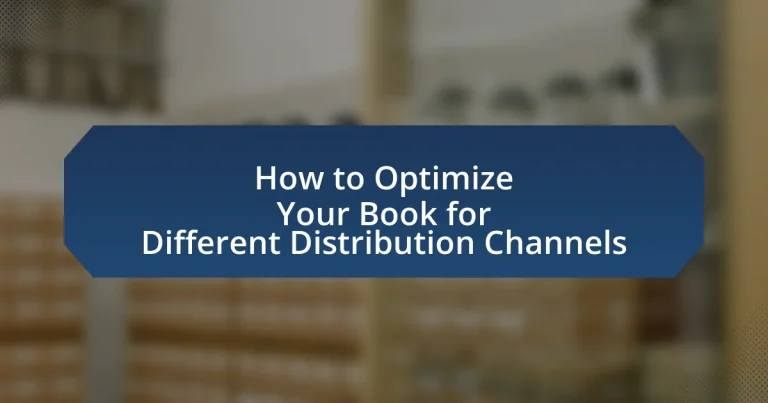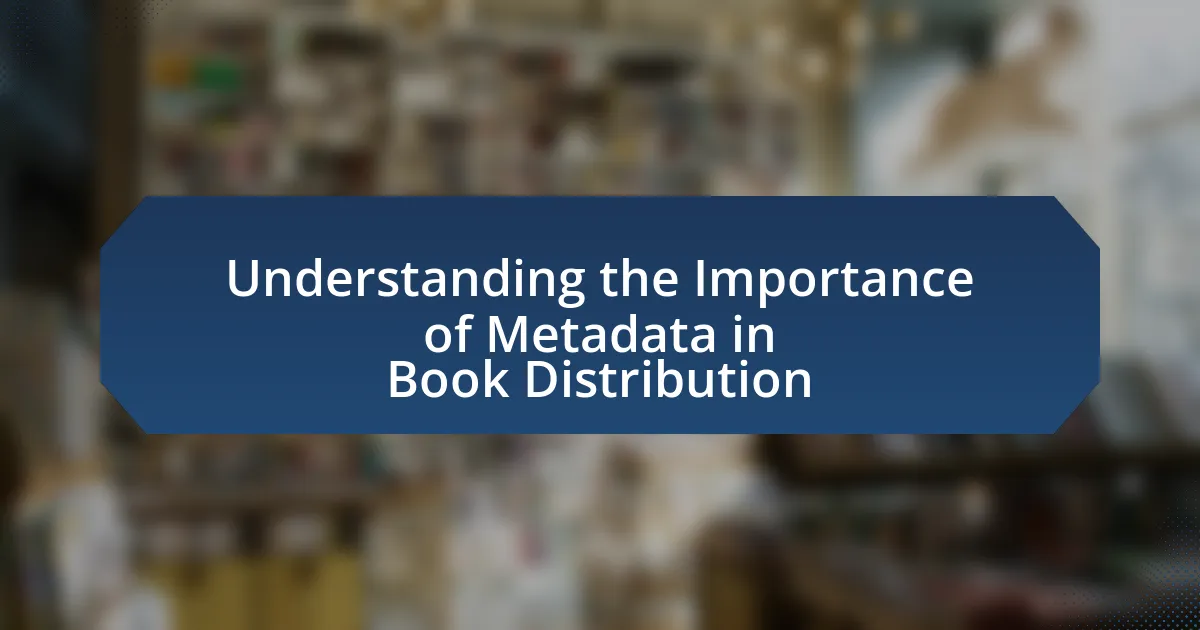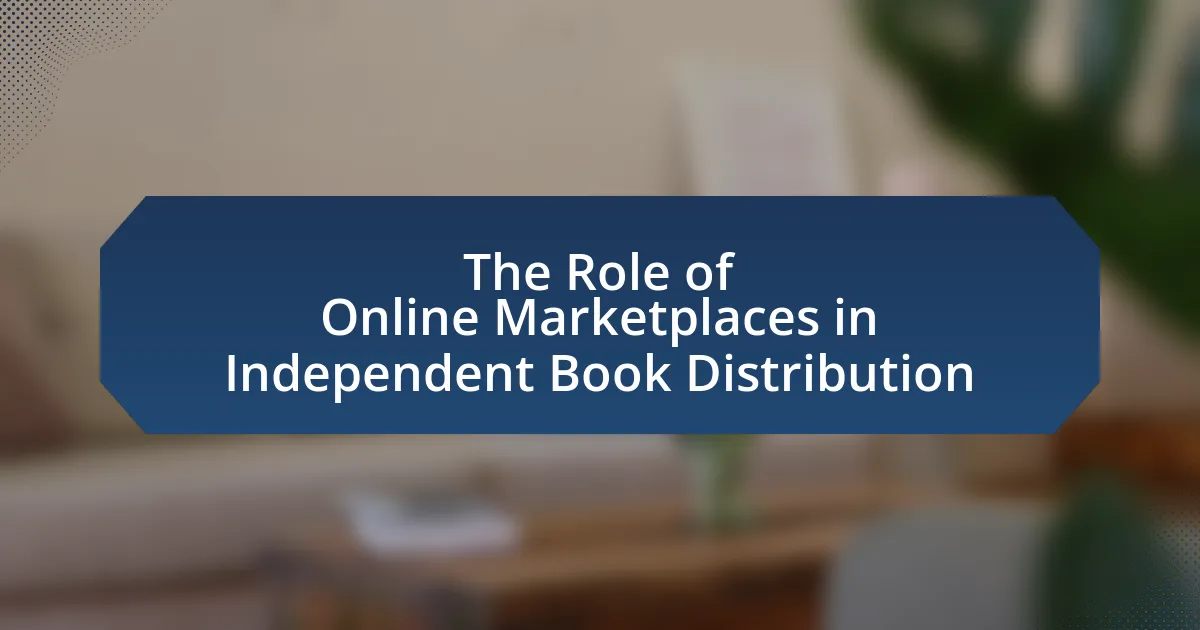The article focuses on optimizing books for various distribution channels, emphasizing the importance of tailoring formats, pricing, and marketing strategies to meet the specific requirements of platforms such as Amazon, bookstores, and libraries. It discusses how understanding distribution channels can enhance book sales by strategically placing titles where target readers are most likely to purchase them. Key characteristics of different channels, the impact of visibility, and the necessity of customization are explored, alongside practical strategies for online and physical distribution. The article also addresses challenges authors may face in maintaining consistent branding, managing pricing, and overcoming logistical issues, providing actionable tips for successful optimization across multiple channels.

What does it mean to optimize your book for different distribution channels?
Optimizing your book for different distribution channels means tailoring the book’s format, pricing, and marketing strategies to suit the specific requirements and preferences of each channel. This process involves understanding the unique characteristics of each distribution platform, such as Amazon, bookstores, or libraries, and adjusting aspects like cover design, metadata, and promotional tactics accordingly. For instance, research indicates that eBooks often require different formatting than print books, and pricing strategies may vary based on the channel’s audience and competition. By aligning the book’s attributes with the expectations of each distribution channel, authors can enhance visibility, increase sales, and reach a broader audience.
How can understanding distribution channels enhance book sales?
Understanding distribution channels enhances book sales by allowing authors and publishers to strategically place their books where target readers are most likely to purchase them. By analyzing various channels such as online retailers, brick-and-mortar stores, and libraries, stakeholders can identify the most effective platforms for reaching their audience. For instance, data from the Association of American Publishers indicates that e-book sales accounted for 20% of the overall book market in 2020, highlighting the importance of digital distribution. Additionally, optimizing for specific channels can lead to increased visibility and accessibility, ultimately driving higher sales volumes.
What are the key characteristics of various distribution channels?
The key characteristics of various distribution channels include direct and indirect methods, accessibility, cost-effectiveness, and target audience reach. Direct distribution channels, such as selling through an author’s website, provide greater control over pricing and customer interaction, while indirect channels, like bookstores and online retailers, offer wider market access but less control. Accessibility refers to how easily consumers can obtain the product, with online channels typically providing greater convenience. Cost-effectiveness is crucial, as different channels incur varying expenses, impacting overall profitability. Lastly, understanding the target audience is essential, as certain channels may resonate more with specific demographics, influencing sales performance.
How do different channels impact the visibility of your book?
Different channels significantly impact the visibility of your book by determining how and where potential readers can discover it. For instance, online retailers like Amazon provide extensive reach and visibility due to their large customer base and advanced algorithms that recommend books based on user preferences. In contrast, local bookstores may offer limited visibility but can create a personal connection with the community, enhancing word-of-mouth promotion. Additionally, social media platforms allow authors to engage directly with readers, increasing visibility through shares and interactions. Research indicates that books promoted through multiple channels, such as social media, email newsletters, and online ads, experience higher visibility and sales compared to those marketed through a single channel. This multi-channel approach leverages diverse audiences and maximizes exposure, ultimately leading to greater success in reaching potential readers.
Why is it important to tailor your book for specific distribution channels?
Tailoring your book for specific distribution channels is crucial because it enhances visibility and sales potential. Different channels cater to distinct audiences and have unique formatting, pricing, and marketing requirements. For instance, eBook platforms like Amazon Kindle require specific file formats and metadata optimization to improve discoverability, while print-on-demand services may necessitate different cover designs and print specifications. Research indicates that books optimized for their distribution channels can see up to a 30% increase in sales compared to those that are not tailored, demonstrating the significant impact of channel-specific strategies on overall performance.
What are the potential risks of a one-size-fits-all approach?
The potential risks of a one-size-fits-all approach include the inability to meet diverse audience needs, leading to decreased engagement and sales. This approach often overlooks the unique preferences and behaviors of different market segments, which can result in a product that fails to resonate with specific groups. For instance, research by the Nielsen Company indicates that tailored marketing strategies can increase customer engagement by up to 30%, highlighting the importance of customization. Additionally, a lack of adaptability can hinder a brand’s competitiveness, as competitors who employ targeted strategies may capture market share more effectively.
How can targeted optimization improve reader engagement?
Targeted optimization can significantly improve reader engagement by tailoring content to meet the specific preferences and behaviors of different audience segments. By analyzing reader data, such as demographics and reading habits, authors can adjust their writing style, themes, and marketing strategies to resonate more effectively with their target audience. For instance, a study by the Nielsen Company found that personalized content can increase engagement rates by up to 50%, demonstrating that when readers encounter material that aligns with their interests, they are more likely to interact with it. This strategic approach not only enhances the reading experience but also fosters a deeper connection between the reader and the material, ultimately leading to higher retention and satisfaction rates.

What strategies can be employed to optimize your book for online distribution?
To optimize your book for online distribution, focus on effective metadata management, targeted marketing, and leveraging multiple platforms. Properly crafted metadata, including keywords, categories, and descriptions, enhances discoverability on platforms like Amazon and Google Books. Research indicates that books with optimized metadata can see up to a 30% increase in visibility. Additionally, utilizing social media and email marketing to reach specific audiences can drive sales; studies show that targeted campaigns yield higher engagement rates. Finally, distributing your book across various platforms, such as Kindle Direct Publishing, IngramSpark, and Smashwords, maximizes reach and potential sales, as each platform has unique audiences and distribution networks.
How do eBook platforms differ in their requirements and audience?
eBook platforms differ significantly in their requirements and audience. For instance, Amazon Kindle Direct Publishing (KDP) mandates specific formatting, such as MOBI or KPF files, and targets a broad audience of general readers, while platforms like Apple Books require EPUB formats and cater to a more tech-savvy demographic. Additionally, platforms like Smashwords emphasize metadata and distribution to libraries, appealing to independent authors and niche markets. These differences in technical specifications and target audiences highlight the need for authors to tailor their content and formatting to each platform’s unique guidelines and user base.
What formatting considerations should be made for eBooks?
eBooks should be formatted to ensure compatibility across various devices and platforms. Key considerations include using a flexible layout that adapts to different screen sizes, employing standard file formats like EPUB or MOBI, and ensuring proper use of headings, fonts, and spacing for readability. Additionally, incorporating metadata is essential for discoverability, while including interactive elements like hyperlinks can enhance user engagement. These practices are supported by industry standards, such as the International Digital Publishing Forum’s EPUB specification, which emphasizes the importance of responsive design and accessibility in eBook formatting.
How can metadata influence discoverability on online platforms?
Metadata significantly influences discoverability on online platforms by providing essential information that helps categorize and index content effectively. When metadata is accurately structured, it enhances search engine optimization (SEO), making it easier for users to find specific books through search queries. For instance, including relevant keywords in the title, author name, and description can lead to higher visibility in search results. Research indicates that 70% of consumers discover new books through online searches, underscoring the importance of well-optimized metadata in reaching potential readers.
What role do social media and online marketing play in book distribution?
Social media and online marketing are crucial for book distribution as they enhance visibility and engagement with potential readers. These platforms allow authors and publishers to reach a global audience, facilitating direct communication and promotion of their books. For instance, a study by the Pew Research Center indicates that 72% of adults in the U.S. use social media, providing a vast pool for targeted marketing campaigns. Additionally, online marketing strategies, such as email newsletters and pay-per-click advertising, can drive traffic to sales platforms, increasing the likelihood of purchases. This integration of social media and online marketing not only broadens the distribution network but also fosters community building around the book, leading to higher sales and sustained interest.
How can social media campaigns be tailored for different platforms?
Social media campaigns can be tailored for different platforms by adapting content formats, messaging styles, and audience engagement strategies to fit the unique characteristics of each platform. For instance, Instagram prioritizes visual content, so campaigns should focus on high-quality images and short videos, while Twitter requires concise messaging and timely updates due to its character limit. Additionally, Facebook allows for longer posts and community engagement, making it suitable for storytelling and discussions. Research indicates that campaigns optimized for platform-specific features can increase engagement rates by up to 50%, demonstrating the effectiveness of this tailored approach.
What are effective strategies for engaging with readers online?
Effective strategies for engaging with readers online include utilizing social media platforms, creating interactive content, and fostering community through direct communication. Social media platforms like Facebook, Twitter, and Instagram allow authors to share updates, engage in conversations, and promote their work, reaching a wider audience. Interactive content, such as polls, quizzes, and live Q&A sessions, encourages reader participation and enhances their connection to the author. Additionally, fostering community through direct communication, such as responding to comments and emails, builds loyalty and encourages ongoing engagement. Research indicates that authors who actively engage with their audience can increase reader retention and satisfaction, leading to higher sales and positive word-of-mouth promotion.

How can you optimize your book for physical distribution channels?
To optimize your book for physical distribution channels, ensure it has an appealing cover design and a well-crafted back cover blurb. An attractive cover can significantly increase visibility and sales, as studies show that 75% of consumers judge a book by its cover. Additionally, consider the book’s trim size and weight, as these factors affect shipping costs and shelf space in retail environments. Research indicates that books with standard sizes are more likely to be stocked by retailers. Finally, establish relationships with distributors and retailers to facilitate better placement and promotion of your book in physical stores.
What are the key factors to consider when working with bookstores and retailers?
The key factors to consider when working with bookstores and retailers include understanding their target audience, establishing strong relationships, and ensuring competitive pricing. Bookstores and retailers cater to specific demographics, so aligning your book’s content and marketing with their customer base is essential for successful collaboration. Building strong relationships with bookstore owners and staff fosters trust and can lead to better promotional opportunities. Additionally, competitive pricing is crucial; research shows that books priced within the market range are more likely to be stocked and promoted, as retailers aim to maximize their profit margins while appealing to customers.
How can you create appealing promotional materials for physical sales?
To create appealing promotional materials for physical sales, focus on high-quality visuals, clear messaging, and targeted design. High-quality visuals, such as professional photographs or graphics, attract attention and convey professionalism, which is crucial for engaging potential customers. Clear messaging ensures that the key benefits and features of the product are communicated effectively, allowing customers to quickly understand the value proposition. Targeted design involves tailoring the materials to the specific audience, using colors, fonts, and layouts that resonate with them. Research indicates that visually appealing promotional materials can increase customer engagement by up to 80%, highlighting the importance of aesthetics in marketing.
What are the benefits of local author events and signings?
Local author events and signings provide significant benefits, including community engagement, increased visibility for the author, and direct sales opportunities. These events foster a personal connection between authors and readers, enhancing the reader’s experience and loyalty. According to a study by the American Booksellers Association, 70% of consumers prefer to buy books from local authors at events, which boosts local sales and supports the local economy. Additionally, authors can gather valuable feedback and insights from attendees, which can inform future writing projects.
How does print-on-demand technology affect book distribution?
Print-on-demand technology significantly streamlines book distribution by enabling publishers to print copies only as orders are received, thereby reducing inventory costs and minimizing waste. This model allows authors and small publishers to distribute their books globally without the need for large upfront investments in print runs. According to a report by the Book Industry Study Group, print-on-demand has led to a 30% increase in the availability of titles, as it allows for a broader range of books to be offered without the constraints of traditional printing methods. Consequently, this technology enhances accessibility for readers and provides authors with more opportunities to reach diverse markets.
What are the advantages of using print-on-demand services?
Print-on-demand services offer several advantages, including reduced upfront costs, inventory management, and customization options. By eliminating the need for large print runs, authors and publishers can produce books as orders come in, which minimizes financial risk and storage issues. According to a study by the Book Industry Study Group, print-on-demand can significantly lower the barrier to entry for self-publishing, allowing more authors to enter the market without substantial investment. Additionally, these services enable authors to easily update content and designs, ensuring that their work remains relevant and appealing to readers.
How can print-on-demand impact inventory management?
Print-on-demand significantly reduces the need for traditional inventory management by allowing businesses to produce items only as they are ordered. This model eliminates excess stock and minimizes storage costs, as products are printed and shipped directly to customers without the need for pre-manufactured inventory. According to a study by the Print-on-Demand Association, companies utilizing print-on-demand can reduce inventory holding costs by up to 30%, leading to improved cash flow and operational efficiency. This shift not only streamlines inventory processes but also allows for greater flexibility in product offerings, as businesses can easily update designs or titles without the risk of unsold inventory.
What are the best practices for optimizing your book across multiple channels?
To optimize your book across multiple channels, ensure consistent branding, tailor content for each platform, and utilize analytics for performance tracking. Consistent branding across channels, including cover design and author bio, reinforces recognition and trust among readers. Tailoring content involves adjusting descriptions, keywords, and promotional strategies to fit the unique audience and algorithms of each platform, such as Amazon, Goodreads, or social media. Utilizing analytics tools, like Google Analytics or platform-specific insights, allows authors to track engagement and sales data, enabling informed adjustments to marketing strategies. These practices enhance visibility and sales potential across diverse distribution channels.
How can you maintain a consistent brand message across different platforms?
To maintain a consistent brand message across different platforms, establish clear brand guidelines that define your voice, tone, and visual elements. These guidelines should be applied uniformly across all channels, including social media, websites, and print materials. Research indicates that brands with consistent messaging can achieve up to 23% more revenue, highlighting the importance of uniformity in communication. By regularly reviewing and updating your content to align with these guidelines, you ensure that your brand remains recognizable and trustworthy to your audience, regardless of the platform.
What tools can assist in tracking performance across distribution channels?
Tools that can assist in tracking performance across distribution channels include Google Analytics, HubSpot, and Tableau. Google Analytics provides insights into website traffic and user behavior, enabling authors to assess the effectiveness of their marketing strategies across various platforms. HubSpot offers comprehensive marketing analytics that track customer interactions and conversions, allowing for a detailed understanding of channel performance. Tableau enables data visualization and analysis, helping authors to interpret complex data sets from multiple distribution channels effectively. These tools collectively enhance the ability to monitor and optimize performance across different distribution avenues.
What common challenges might arise when optimizing for different distribution channels?
Common challenges that arise when optimizing for different distribution channels include maintaining consistent branding, managing varying pricing strategies, and adapting content formats. Consistent branding is crucial as discrepancies can confuse customers and dilute brand identity. For instance, a study by the Journal of Marketing found that 60% of consumers prefer brands that present a unified image across all channels. Additionally, pricing strategies may differ due to channel-specific costs or market expectations, complicating profitability. Adapting content formats is also essential, as each channel may require unique specifications, such as eBook formats for digital platforms versus print layouts for physical books. These challenges necessitate careful planning and execution to ensure effective optimization across all distribution channels.
How can you address issues related to pricing and royalties?
To address issues related to pricing and royalties, authors should conduct thorough market research to understand competitive pricing strategies and royalty structures across various distribution channels. This involves analyzing similar titles in the genre to set a competitive price point while ensuring that the royalty percentage aligns with industry standards, which typically range from 10% to 25% for print books and can be higher for eBooks. Additionally, authors can utilize pricing strategies such as tiered pricing or promotional discounts to enhance visibility and sales, as evidenced by a study from the Book Industry Study Group, which found that strategic pricing can increase sales volume by up to 30%. By regularly reviewing sales data and adjusting prices accordingly, authors can optimize their earnings and address any discrepancies in royalties received.
What strategies can help overcome logistical challenges in distribution?
Implementing technology-driven solutions, such as inventory management systems and route optimization software, can effectively overcome logistical challenges in distribution. These technologies enhance visibility and streamline operations, allowing for real-time tracking of inventory and efficient routing of deliveries. For instance, a study by the Council of Supply Chain Management Professionals found that companies utilizing advanced logistics technologies experienced a 15% reduction in operational costs and a 20% improvement in delivery times. Additionally, fostering strong relationships with reliable logistics partners can further mitigate challenges by ensuring consistent service and support.
What practical tips can help you successfully optimize your book for distribution?
To successfully optimize your book for distribution, focus on formatting it according to the specifications of each distribution channel. Proper formatting ensures compatibility with platforms like Amazon Kindle, Apple Books, and others, which often have specific requirements for file types, dimensions, and layout. Additionally, utilize metadata effectively by including relevant keywords, an engaging book description, and accurate categories to enhance discoverability. Research shows that books with optimized metadata can increase visibility by up to 30% on major platforms. Finally, consider pricing strategies that align with market trends and competitor pricing to attract potential readers while maximizing revenue.




